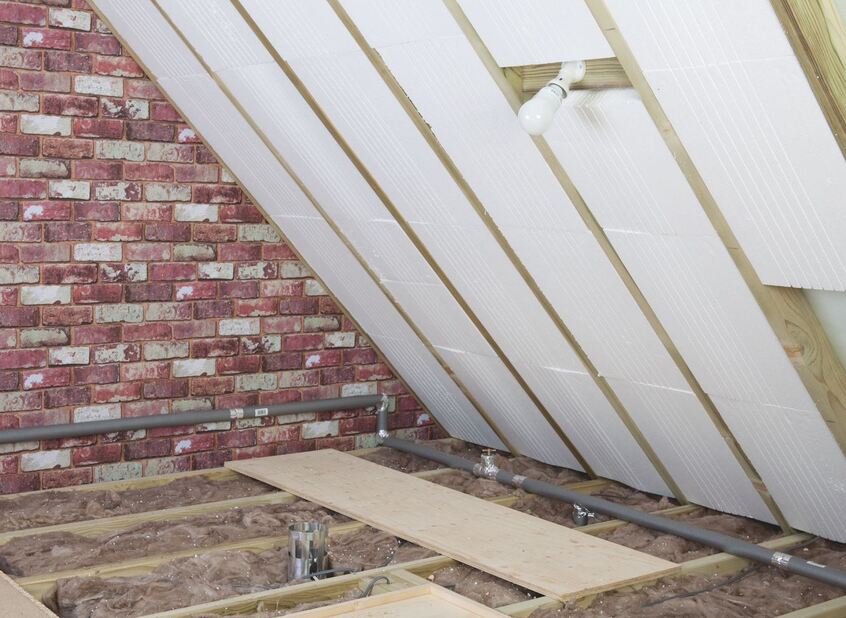
If you’re a hands-on homeowner taking a DIY approach to insulation, it’s important to understand not just the materials you’re working with, but also the techniques and safety precautions involved in the process. While home insulation is a rewarding project that can improve energy efficiency and comfort, it also requires thoughtful planning and proper execution. Here’s what you need to know about how to install ceiling insulation.
Understanding R-Values
Before choosing insulation materials, start by understanding R-value, a key metric in determining thermal performance. R-value measures a material’s resistance to heat flow. The higher the R-value, the greater the insulating power. However, a higher R-value isn’t always better by default. The U.S. Department of Energy recommends different R-values based on your regional climate zone. In colder regions, higher R-values are ideal for ceilings and attics, whereas milder climates may require lower R-values. Additionally, the application location—walls, floors, or ceilings—affects how the insulation performs.
Common Types of Insulation Materials
Effective home insulation typically involves layering multiple materials. Here are some commonly used insulation types:
- Loose Fill Insulation
Made from fiberglass or cellulose, loose fill is blown into place using specialized equipment. It’s great for irregular spaces or hard-to-reach areas like attics or around obstructions. - Batt Insulation
These pre-cut fiberglass or mineral wool panels are designed for easy installation between framing in walls, ceilings, and attics. They’re cost-effective and offer reliable performance for standard framing dimensions. - Cross Linked Polyethylene Foam 2LB (XLPE)
A closed-cell foam that offers excellent thermal insulation, water resistance, and durability. XLPE is often used in commercial and industrial applications, such as expansion joints or thermal barriers, but is also useful for residential projects requiring thick, high-performance foam. - Foam Board Insulation
Rigid panels made from expanded polystyrene (EPS) or extruded polystyrene (XPS) provide a high R-value per inch of thickness. These boards are typically used in wall sheathing or under roofing to minimize thermal bridging across structural elements.
Estimating Material Requirements
To determine how much insulation you need, begin by measuring the square footage of the area you plan to insulate (length × width). If existing insulation is present, assess its R-value and condition to decide whether you need to supplement it or start fresh. For new installations, plan for a layered approach, combining materials such as foam board and batt insulation for maximum thermal efficiency.
Installation Best Practices
When installing ceiling insulation, safety and precision are key. Always wear protective gear, including gloves, a dust mask, long sleeves, and eye protection, as materials like fiberglass can cause skin and respiratory irritation. If you’re working in ceilings or tight attic spaces, be sure to have a partner with you for both efficiency and safety—especially when ladders are involved. Choosing the right adhesive is also important: foam boards may require construction adhesive or mechanical fasteners, while loose-fill insulation typically doesn’t need securing. Always follow the manufacturer’s guidelines for application methods.
For best results, think beyond a single area of the home. Insulating only the attic or walls won’t significantly improve energy efficiency. Instead, take a whole-house approach—covering attics, walls, floors, and sealing air leaks. Use spray foam or adhesive-backed foam tape to seal gaps around windows, doors, and fixtures. These small additions help reduce air transfer, maximizing the effectiveness of your insulation project.
Achieve Whole-Home Comfort with the Right Insulation Approach
Insulating your home isn’t just about comfort. It’s a long-term investment in energy efficiency. By understanding how materials function, choosing appropriate insulation for your space, and taking safety seriously, you can achieve professional-grade results with a DIY approach. For high-performance foam solutions—including cross-linked polyethylene, foam board panels, and custom-cut insulation—we offer a wide range of products to help you complete your project with confidence. Shop our options today, and feel free to reach out with any questions.


I want to put a ridgid foam ceiling in my garage. There is presently no insulation. The rafters are 24 inch centers. I need 14 4×8 sheets. Winter temps are low in the 40s, summer temps are in the high 90s.
I need suggestions as to product to use and prices.
Please Contact Us for further information regarding your application.